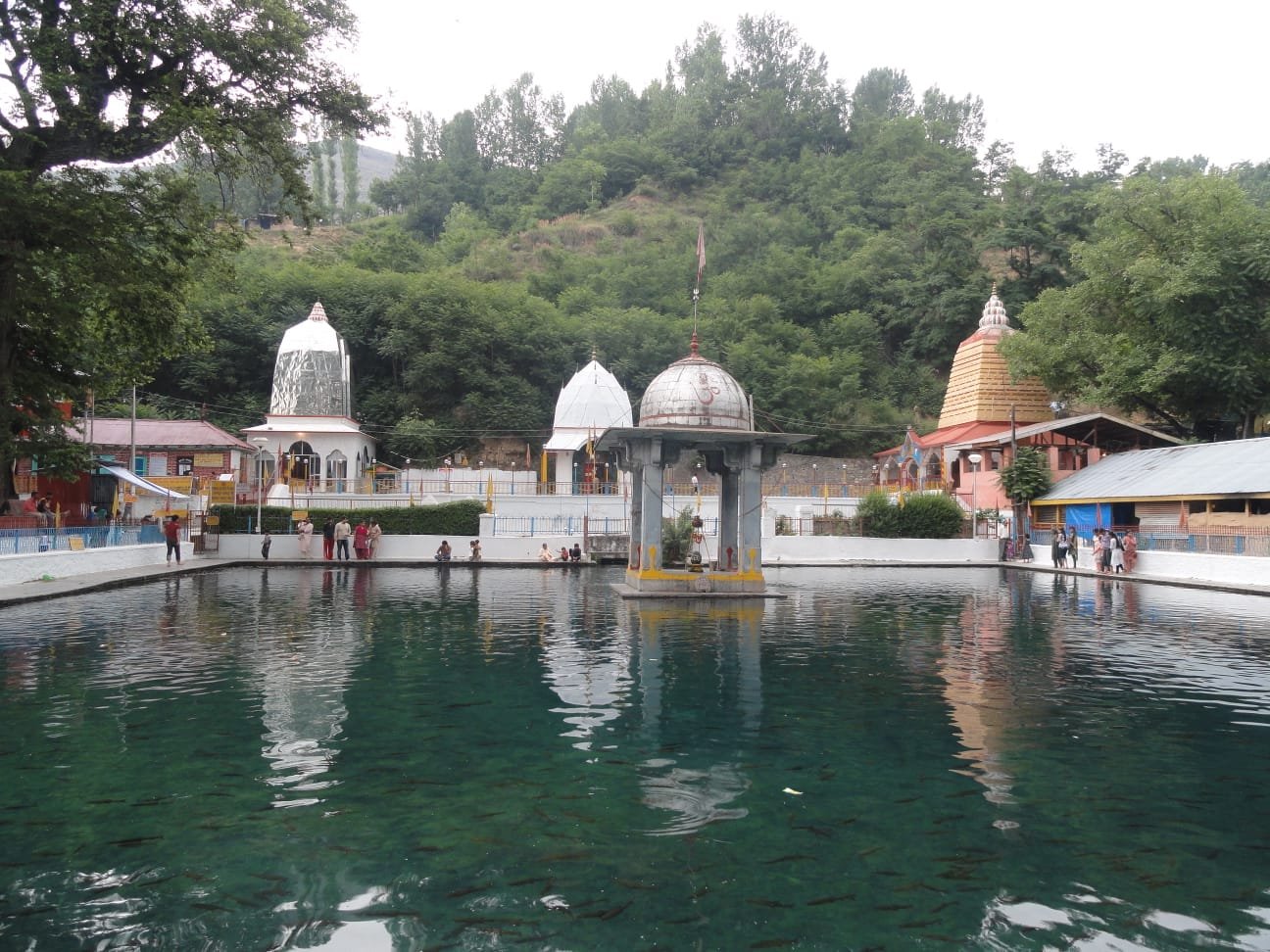1. The Amarnath Yatra
1.1 Origins and Significance
Mythological Roots :
– According to the Amarnath Mahatmya, Lord Shiva chose this cave to reveal the secret of immortality (Amar Katha) to Goddess Parvati.
– The cave is also linked to the Puranas, where Shiva is said to have left behind his son Ganesha and the moon (Chandra) to ensure secrecy.
Historical References :
– The pilgrimage dates back to at least the 15th century, mentioned in texts like Rajatarangini.
– Rediscovered in the 19th century by a Muslim shepherd, Buta Malik, who received a bag of coal that turned into gold. His descendants still receive a share of offerings.
1.2 The Pilgrimage Experience
Routes to the Cave :
– Pahalgam Route (Chandanwari to Cave) :
– Distance : 36–48 km, depending on the path.
Key Stops :
– Chandanwari : Starting point with rituals at a Shiva shrine.
– Sheshnag Lake : A glacial lake surrounded by seven peaks, named after the mythical serpent Shesha.
– Panchtarni : Final camp before the cave, where five rivers converge.
– Duration : 3–5 days, with overnight stops at designated camps.
– Baltal Route :
– Distance : 14 km steep ascent.
– Features : Faster but riskier due to landslides and narrow trails. Helicopter services available from Baltal to Panchtarni.
– Challenges :
– Altitude Sickness : Caused by low oxygen levels at 3,888 meters; symptoms include nausea and dizziness.
– Weather : Sudden snowfall, rain, and sub-zero temperatures even in summer.
– Physical Strain : Elderly pilgrims often use ponies or palanquins (pithoos).
1.3 Rituals and Traditions
– Chhari Mubarak (Holy Mace) Procession :
– Leader : The head priest of the Dashnami Akhara (a Hindu monastic order).
– Ritual Stops :
– Srinagar : Begins at the Dashnami Akhara with Vedic chants.
– Martand Surya Temple Mattan : Blessings sought from Martand Surya Tirath.
– Pahalgam : Sacred bath in the Lidder River.
– Final Ceremony : On Shravan Purnima (full moon), priests perform aarti at the cave.
– Ice Lingam Worship :
– Formation : The lingam waxes from May to August, reaching full height (6–12 feet) by July.
– Offerings : Milk, flowers, and bilva leaves; devotees chant Om Namah Shivaya.
– Symbolism : Represents Shiva’s cyclical power of creation and destruction.
1.4 Modern Management
Registration Process :
– Compulsory Health Checks : ECG, blood pressure, and oxygen levels monitored.
– E-Yatra Permit : Online registration with biometric verification.
Facilities :
– Base Camps : Jammu and Srinagar provide lodging and medical camps.
– Langars : Free meals (e.g., khichdi, tea) organized by religious trusts like ISKCON.
– Technology Integration :
– RFID Tags : Track pilgrims in real-time.
– Mobile Apps : SASB app offers weather updates and emergency contacts.
2. Martand SunTemple (Mattan Ranbir Pura) also known as Padav Lari
2.1 Historical Background
– King Lalitaditya Muktapida :
– Ruler of the Karkota dynasty (8th century CE), known for military conquests and patronage of art.
– Built Martand as part of a grand temple complex to showcase Kashmir’s prosperity.
– Destruction :
– Destroyed in the 15th century by Sultan Sikandar Shah Miri, who enforced iconoclasm.
– Rediscovered by British archaeologist Alexander Cunningham in the 19th century.
2.2 Architectural Grandeur
– Layout :
– Central Sanctum : Housing the Sun God’s idol, aligned to capture sunrise on equinoxes.
– Peristyle Design : 84 columns surrounding the main shrine, reflecting Greco-Roman influence.
– Courtyard : 220 feet long, with smaller shrines dedicated to Vishnu, Ganga, and Shiva.
– Carved Motifs :
– Deities : Sculptures of Surya, Vishnu, and River Goddesses.
– Geometric Patterns : Floral designs and lotus medallions symbolizing cosmic order.
2.3 Cultural and Spiritual Legacy
– Syncretism :
– The temple complex included Buddhist stupas and Zoroastrian fire altars, reflecting Kashmir’s multicultural ethos.
– Annual festivals like Makar Sankranti drew pilgrims from across Asia.
– Modern Relevance :
– A protected monument under the Archaeological Survey of India (ASI).
– Featured in Bollywood films (e.g., Haider) as a symbol of Kashmir’s lost heritage.
2.4 Current State :
– A sprawling, roofless structure with intricate carvings, columns, and a central sanctum.
– Managed by the Archaeological Survey of India (ASI) ; no active worship occurs here.
– A tourist and historical site, often featured in films and documentaries.
3. Active Martand Surya Temple (Main Mattan Market)
– Location : Main Mattan Market, near the sacred Mattan Spring (also called Mattan Nag).
– Status : Functional temple with daily worship and rituals.
Key Features :
– Sacred Spring : The temple complex houses the holy Springs ( Vimal, Kamal and Gouri Kund / Nag), a natural pool fed by underground streams. Devotees believe its waters have purifying properties.
– Deity : The primary idol is Shri Martand Surya Dev , though shrines to Shiva, Vishnu, and other deities are also present.
Rituals :
– Daily aarti and puja performed by priests.
– Devotees offer flowers, rice, and coins to the sacred spring.
– Major festivals: Makar Sankranti , Shivratri Puja , Shri Krishna Janmashtami, and Surya Saptami (dedicated to Surya).
Cultural Significance :
– Known locally as “Mattan Temple” or “Martand Surya Mandir” , it is the active spiritual hub of Mattan.
– Pilgrims en route to Amarnath often stop here to bathe in the sacred spring and seek blessings.
4. Chhari Mubarak Procession & the Active Temple
Correction : Any references to the Chhari Mubarak procession stopping at the Ancient Martand Sun Temple ruins (Padav Lari ) were incorrect. The procession actually halts at the active Martand Surya Temple ( Martand Tirath / Mattan Nag ) in the main Mattan market.
– Ritual Details :
– The holy mace ( Chhari Mubarak ) is brought here for prayers before proceeding to the Amarnath Cave.
– Priests perform abhishek (ritual bath) of the mace with water from the Mattan Spring.
– Devotees gather to sing bhajans and receive blessings.
Why the Confusion?
– Shared Name : Both sites are linked to the name “Martand” (Sanskrit for Sun God), leading to mix-ups.
– Historical Legacy : The active temple likely derives its name and spiritual lineage from the ancient Martand Temple, even though they are distinct sites.
Importance of the Correction
– Cultural Accuracy : The active temple [ Martand Surya Temple ( Martand Tirath / Mattan Nag ) ] in Mattan Main Market is the living center of faith, while the Ancient Martand Sun Temple ruins (Padav Lari ) at Ranbir Pura ,Mattan is a historical relic.
– Pilgrim Context : Amarnath Yatra pilgrims visit the active Martand Surya Temple (not the ruins) for rituals, making this distinction critical for accurate guidguidance.
4. Sacred Link: Chhari Mubarak at Martand Temple
4.1 Ritual Convergence
Procession Stop :
– Timing : 2–3 days before reaching the Amarnath Cave.
– Rituals :
– Abhishek : The mace is bathed in milk and honey.
– Vedic Hymns : Priests chant Rigvedic verses dedicated to Surya.
– Symbolic Unity : Honors the interdependence of Shiva (transcendence) and Surya (life-giving energy).
4.2 Reviving Heritage
– Community Participation :
– Local Kashmiri Pandits, Sikhs and Muslims collaborate to maintain the temple premises during the Yatra.
– Political Significance :
– The stop underscores Kashmir’s Hindu identity, countering narratives of erasure.
The Amarnath Yatra and Martand Sun Temple are not just monuments of stone and ice but living embodiments of India’s spiritual resilience.
Bam Bam Bhole!
Jai Shri Martand!

